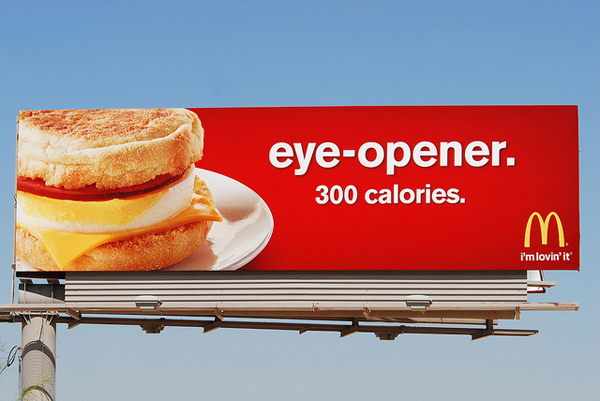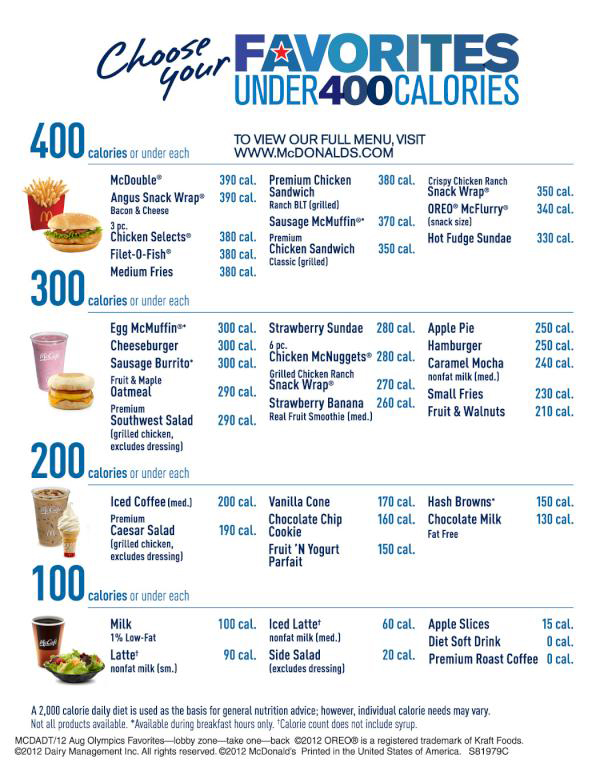Ever wonder how many calories are in a McDonald’s meal? If you do want to know just how nutritionally void that Big Mac is, you would have to pull up the information on the restaurant’s web site. Until now!
Today, the corporation announced that they will list nutrition information on restaurant and drive-thru menus nationwide. President Obama’s new health regulation requires restaurant chains to post calorie information. McDonald’s move comes ahead of federal government regulation that could require major chains to post nutrition information as early as next year.
Jan Fields, president of McDonald’s USA, said in a press release that the company volunteered to give out their nutrition information. “We believe it will help educate customers.”
I asked our resident dietitian, Mary Hartley, what she thinks of McDonald’s providing their nutrition information, and she said, “It’s good publicity and they (McDonalds) know it really won’t make a difference, but who knows what will happen over time. Many people have no idea of how many calories they need and so the information is meaningless.” She points to the fact that New York City has required calories posted on menus for several years and it’s done little to change buyer behavior there.
McDonald’s started advertising the “Favorites Under 400” campaign, that highlights food items under 400 calories, during the Summer Olympics, likely to combat the bad press of a fast food restaurant being a major food sponsor of the most elite athletes in the world. The company said about 80 percent of their menu is less than 400 calories. McDonald’s menu items may have less calories then consumers’ expect, but calories add up. People tend to get an order of fries and soda with their orders, and eating all three of these items will send calorie counts through the roof.
For example a Big Mac, medium fries, and 16 oz. Coca-Cola has 1,140 calories. And, that’s only one meal for the day! It is almost half the daily recommended calories.
Take a look at McDonald’s hamburger: 250 calories, 9 grams of fat, 490 milligrams of sodium, 6 grams of sugar, and 12 grams of protein. “I can tell that a McDonald’s hamburger is made with fattier beef than I would use at home and the portion is smaller (12 grams of protein compared to 26),” said Mary.
Less than 400 calories for the serving looks good, but those are 250 nutrition-void calories, with the fatty beef, bleached white bun, and no fresh vegetables. Basically, anyone consuming a hamburger from McDonald’s isn’t getting a whole lot of nutrients. There is lots of processed fat in McDonald’s food, which is linked to obesity.
Also, Mary mentioned, “The problem with McDonald’s has more to do with the absence of vegetables, the fact that the rest of the food is mostly fried (people are less likely to fry at home), that restaurants use high-test grease that contains more trans fat and additives, and frequenting sends the message that it’s OK to eat fast food regularly when it’s not.”
Will McDonald’s nutrition information benefit society? Will people stop eating at McDonald’s because of the nutrition information? Will McDonald’s provide healthier meals? Only time will answer those questions, or maybe it already has. NYC has posted the calories on the menu for several years, and Mary said, “it hasn’t significantly affected the way people order, especially in poor neighborhoods.”
We certainly applaud McDonald’s for leading the pack in posting this information in their restaurants, and we hope more people consider that information when ordering. But we also hope they aren’t sold by low, nutritionally void numbers.
Also Read:
New York’s Ban on Trans Fats is Working
Organic vs Non-Organic: Battle of the Packaged Foods
9 Good-for-You Goodies Worth the Indulgence
images via social-brain.com and burgerbusiness.com


